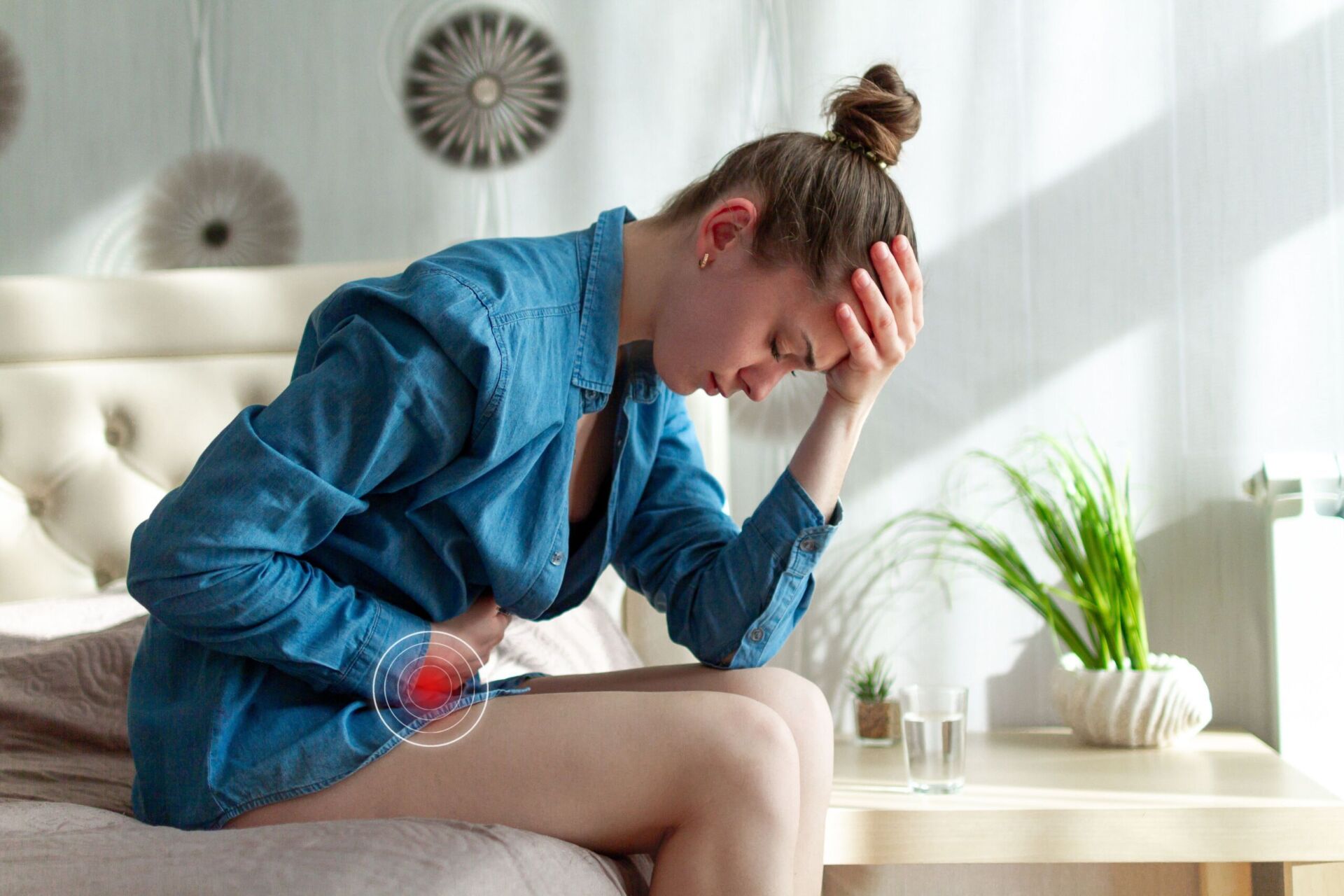Overview: What is abdominal pain in women?
Abdominal pain is limited to the pelvis, but can include discomfort that is below the belly button in the area of the abdominal wall to the front and includes the area of the lumbar spine, coccyx to the buttocks to the back.
Every woman probably has to deal with abdominal pain in her life, usually often. Especially during monthly menstruation, pain in the lower abdomen is a regular companion. It aches and pinches in the lower abdomen. The pain varies in severity from woman to woman. Regardless of this, non-menstrual abdominal pain can also occur and can last for different lengths of time. The lower abdominal pain is then not the same every day, but can increase and also decrease again within a short time. If this non-menstrual abdominal pain lasts more than six months, it is called chronic pelvic pain. If the pain occurs suddenly, it is called acute abdominal pain.
Pain is generally not considered a disease in its own right, but a symptom that something is wrong in the body or that certain natural processes are underway. Lower abdominal pain can have many different causes – not just menstruation. It may be related to a disease, such as of the uterus, fallopian tubes or ovaries. But other organs and tissues located in the abdominal cavity may also be diseased and cause pain. These can be urinary tract and gastrointestinal diseases. Sometimes the pain radiates from another organ into the lower abdomen – women then perceive it there.
The treatment of abdominal pain always depends on the cause. This is how doctors treat the underlying disease that leads to the pain in the lower abdomen. Painkillers that also have an anti-inflammatory effect are helpful. But also home remedies such as heat have a relaxing effect and relieve especially the cramping lower abdominal pain. With bacterial infections, for example, antibiotics are used; with other diseases, surgery is sometimes necessary. In chronic lower abdominal pain, it is often not possible to find a single underlying disease as the trigger of the pain. The pain has then become a disease itself.
Abdominal pain in women – frequency and age
The incidence of abdominal pain cannot be accurately quantified. In particular, menstruation-related lower abdominal pain is a very common symptom. For hardly any woman, menstruation is painless. However, many gynecological and other conditions can also be linked to abdominal pain. Chronic abdominal pain, on the other hand, is less common, but then it is usually found together with other pain disorders.
An exact age at which abdominal pain occurs cannot be determined. Menstrual pain can affect girls as well as young and older women. Gynecological diseases often occur in women of childbearing age. And if the pain in the abdomen has other causes, women of any age can be affected.
Abdominal pain in women: Overview of causes
The causes of abdominal pain in women can be extremely diverse and varied. During menstruation they are practically normal. They result from the uterus contracting to shed the built-up uterine lining. If no fertilized egg has implanted and the woman has not become pregnant, the lining has become redundant. The body discharges it along with the menstrual blood. With the end of the menstrual period, the pain subsides again – only to start again at the onset of the next menstruation. Some women also feel a pulling sensation in the abdomen when they ovulate around mid-cycle.
Severe menstrual pain is what gynecologists call dysmenorrhea. Despite taking painkillers, this period pain cannot be controlled and leads in each case to significant restrictions in everyday life. They may indicate endometriosis, a benign growth of the uterine lining outside the uterine cavity. This leads to an inflammatory response in the pelvic area with increased production of prostaglandins (hormones that cause the uterus to contract). Less frequently, fibroids (nodular muscle changes in the uterine wall) can also cause increased period pain associated with heavy menstrual bleeding and resulting cramping contraction of the uterus.
Abdominal pain without period: gynecological diseases
Abdominal pain that occurs independently of menstruation can have many different causes, such as gynecological diseases. Some examples:
- Endometriosis (proliferation of the uterine lining outside the uterine cavity)
- Ovary/ Fallopian tube inflammation
- Cysts on the ovaries
- Inflammation of the endometrium
- Ectopic pregnancy – in this case the fertilized egg does not nest in the uterus but in the fallopian tube
- benign tumors, for example fibroids – these are growths in the muscular layer of the uterus
- Descent of the uterus or vagina with pain/feeling of foreign body
- malignant tumors (for example uterine cancer, ovarian cancer)
Abdominal pain can also occur during pregnancy – always see your doctor to be on the safe side. The pain is not necessarily dangerous, but it can be a warning sign of pregnancy complications: Premature birth or miscarriage, detachment of the placenta or rupture of the uterus. And a natural birth always begins with contractions anyway, which can be extremely painful.
Abdominal pain without period: other diseases
In addition, diseases of other organs in the abdominal cavity are possible causes of abdominal pain in women. They range from infections to appendicitis.
- Intestine: constipation, food intolerances such as lactose intolerance or gluten intolerance = celiac disease, irritable bowel syndrome (IBS), chronic inflammatory bowel diseases such as Crohn’s disease or ulcerative colitis, diverticulitis (inflamed protrusions of the intestinal mucosa), appendicitis, intestinal cancer, intestinal obstruction.
- Urinary tract: cystitis, renal pelvic inflammation, urinary stones, irritable bladder, bladder cancer
- “Pelvic Congestion” Syndrome (Pelvic Vein “Varices”):Blood congestion in the uterus, ovary or pelvic vein area can cause a painful feeling of heaviness, especially at the end of the day or after standing for long periods of time.
- Abdominal aortic aneurysm (sometimes): An outpouching of the aorta in the abdomen
Other diseases
- Diseases of the lumbar spine, pelvic bones or their joints.
- Painful conditions of the pelvic floor muscles
- Adhesions in the abdominal cavity, for example after surgery
- Inguinal hernia
The psyche can also play a role in abdominal pain. Examples include stress, burnout, psychological trauma, sexual problems, anxiety disorders or depression can increase or even maintain pain.
Symptoms: abdominal pain in women
Abdominal pain in women is not a disease in its own right, but a symptom that certain processes are going on in the body or that there is a health problem. Most often, lower abdominal pain is related to menstruation, but other conditions can also be to blame.
Abdominal pain may start acutely and subside within a short time (with or without treatment). However, they can also become chronic and then last longer. The intensity of pain is also individual and varies depending on the cause. Some women experience only minor pain, while others are plagued by the most severe abdominal pain. In general, pain has a decisive impact on the quality of life.
In addition, the character of pain can vary and women feel abdominal pain differently:
- cramping or colicky pain that is often very severe
- piercing
- oppressive
- dull
- searing
- sharp
- burning
The abdominal pain can go in waves – then phases with and without pain alternate. Sometimes they are also permanently present and there are no pain-free intervals. Constant abdominal pain that lasts six months or longer is what doctors call chronic.
Depending on the cause, abdominal pain may be joined by other symptoms.
- Nausea, nausea and vomiting
- Sweating
- Trembling
- Dizziness
- altered bowel movements, for example constipation, diarrhea
Abdominal pain in women: Diagnosis by us
Abdominal pain during menstruation is normal for many women. Nevertheless, you should ask your gynecologist for advice, because there are effective remedies. You should also seek medical advice for lower abdominal pain that is not related to menstruation. There may also be various diseases behind it – gynecological and non-gynecological. We will first ask you about your medical history (anamnesis). For example, the following points are interesting:
- How long have you had abdominal pain?
- Did they occur suddenly/suddenly, or did they come gradually?
- Where exactly would you locate the pain? For example, left, right, both sides, rather top, bottom or center?
- Does the pain radiate to other areas of the body, such as the back or legs?
- How does the pain feel (for example, pulling, pressing, cramping)?
- How severe is the abdominal pain?
- Do they improve or intensify in phases?
- Are there situations that trigger, increase or improve abdominal pain?
- Does abdominal pain occur after certain events, such as eating certain foods?
- Are there other complaints in addition to the pain?
- Do you have any known diseases?
- Have you ever had abdominal surgery?
Your answers already provide us with initial clues as to what could be the cause of the abdominal pain. This is followed by a physical examination, during which we palpate the abdomen with our hands. We sense which areas are sensitive to pressure and touch or are particularly sensitive to pain. In addition, we listen to the abdomen and can detect unusual sounds. In this way, we can already narrow down the causes.
A gynecological examination provides further clues as to the reason for the abdominal pain. We palpate the vagina and uterus. Colposcopy is also used – an examination with a special instrument (colposcope), which has a magnifying lens, for example, to get indications of cervical inflammation. A vaginal ultrasound (vaginal sonography) is extremely helpful: This allows any changes in the uterus or ovaries to be detected. A smear provides information about infections and possible pathogens.
Other tests for abdominal pain include:
- Blood test – the blood values provide information about inflammations and the condition of the organs
- Urinalysis
- Stool examination
- Ultrasound of the abdomen (abdominal sonography)
- X-ray examination
- Computed tomography (CT)
- Magnetic resonance imaging (MRI= magnetic resonance imaging)
- Abdominal endoscopy (laparoscopy) for abdominal pain lasting longer than six months
Abdominal pain in women: Prevention, early detection, prognosis
There are no special medical measures to prevent abdominal pain in women. There are also no known specific measures for early detection of lower abdominal pain in the physician’s office. Some women benefit from strategies that include a healthy lifestyle. A healthy diet, plenty of exercise and relaxation can sometimes be effective in prevention.
Otherwise, the general advice is: always seek medical advice promptly for lower abdominal pain that you cannot classify (for example, outside of menstruation). The same applies if the pain does not improve within a short time or even intensifies. And if other symptoms are added, such as nausea and vomiting, a quick visit to the doctor is also advisable. In the case of an ectopic pregnancy or appendicitis, for example, quick action is required. This is because there is a risk of internal bleeding or rupture of the appendix, which can be life-threatening.
Course and prognosis for abdominal pain in women
The course and prognosis of abdominal pain cannot be generally predicted. They always depend on the cause. Lower abdominal pain associated with menstruation usually resolves on its own or with treatment. However, they usually start again with the onset of the next menstrual period.
If there is a disease behind the lower abdominal pain, we need to treat this underlying disease to improve the symptoms. How well this succeeds in turn determines the course and prognosis. However, sometimes the lower abdominal pain becomes chronic. Then they are present for a longer period of time and significantly reduce the joy of life and quality of life. It is then important to provide adequate pain management. It belongs in the hands This should be in the attention of a pain medicine specialist.
Abdominal pain in women: Treatment depending on the cause
The treatment of abdominal pain in women depends largely on the cause. There are effective painkillers and proven home remedies, but sometimes surgery is necessary. There are several pain management options that quickly improve occasional pain. If a disease is the cause of the lower abdominal pain, we must always treat it. The goal is to relieve pain, prevent it from returning, and improve quality of life.


